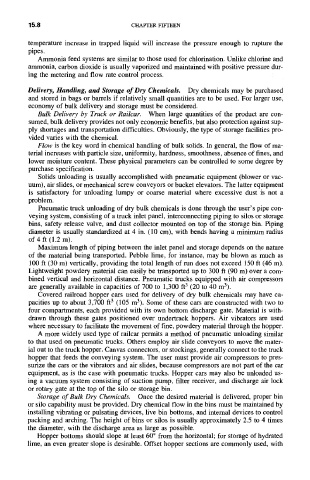Page 498 -
P. 498
15.8 CHAPTER FIFTEEN
temperature increase in trapped liquid will increase the pressure enough to rupture the
pipes.
Ammonia feed systems are similar to those used for chlorination. Unlike chlorine and
ammonia, carbon dioxide is usually vaporized and maintained with positive pressure dur-
ing the metering and flow rate control process.
Delivery, Handling, and Storage of Dry Chemicals. Dry chemicals may be purchased
and stored in bags or barrels if relatively small quantities are to be used. For larger use,
economy of bulk delivery and storage must be considered.
Bulk Delivery by Truck or Railcar. When large quantities of the product are con-
sumed, bulk delivery provides not only economic benefits, but also protection against sup-
ply shortages and transportation difficulties. Obviously, the type of storage facilities pro-
vided varies with the chemical.
Flow is the key word in chemical handling of bulk solids. In general, the flow of ma-
terial increases with particle size, uniformity, hardness, smoothness, absence of fines, and
lower moisture content. These physical parameters can be controlled to some degree by
purchase specification.
Solids unloading is usually accomplished with pneumatic equipment (blower or vac-
uum), air slides, or mechanical screw conveyors or bucket elevators. The latter equipment
is satisfactory for unloading lumpy or coarse material where excessive dust is not a
problem.
Pneumatic truck unloading of dry bulk chemicals is done through the user's pipe con-
veying system, consisting of a truck inlet panel, interconnecting piping to silos or storage
bins, safety release valve, and dust collector mounted on top of the storage bin. Piping
diameter is usually standardized at 4 in. (10 cm), with bends having a minimum radius
of 4 ft (1.2 m).
Maximum length of piping between the inlet panel and storage depends on the nature
of the material being transported. Pebble lime, for instance, may be blown as much as
100 ft (30 m) vertically, providing the total length of run does not exceed 150 ft (46 m).
Lightweight powdery material can easily be transported up to 300 ft (90 m) over a com-
bined vertical and horizontal distance. Pneumatic trucks equipped with air compressors
are generally available in capacities of 700 to 1,300 ft 3 (20 to 40 m3).
Covered railroad hopper cars used for delivery of dry bulk chemicals may have ca-
pacities up to about 3,700 ft 3 (105 m3). Some of these cars are constructed with two to
four compartments, each provided with its own bottom discharge gate. Material is with-
drawn through these gates positioned over undertrack hoppers. Air vibrators are used
where necessary to facilitate the movement of fine, powdery material through the hopper.
A more widely used type of railcar permits a method of pneumatic unloading similar
to that used on pneumatic trucks. Others employ air slide conveyors to move the mater-
ial out to the truck hopper. Canvas connectors, or stockings, generally connect to the truck
hopper that feeds the conveying system. The user must provide air compressors to pres-
surize the cars or the vibrators and air slides, because compressors are not part of the car
equipment, as is the case with pneumatic trucks. Hopper cars may also be unloaded us-
ing a vacuum system consisting of suction pump, filter receiver, and discharge air lock
or rotary gate at the top of the silo or storage bin.
Storage of Bulk Dry Chemicals. Once the desired material is delivered, proper bin
or silo capability must be provided. Dry chemical flow in the bins must be maintained by
installing vibrating or pulsating devices, live bin bottoms, and internal devices to control
packing and arching. The height of bins or silos is usually approximately 2.5 to 4 times
the diameter, with the discharge area as large as possible.
Hopper bottoms should slope at least 60 ° from the horizontal; for storage of hydrated
lime, an even greater slope is desirable. Offset hopper sections are commonly used, with

